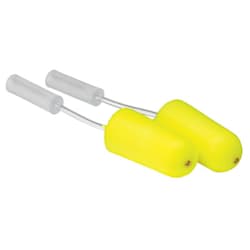Safety Guidelines for Wearing the Proper Gloves for Fentanyl Exposure
Gloveworks® Exam Black Nitrile Gloves deliver consistent, dependable barrier protection against biological hazards and exposure to fentanyl (tested to resist permeation against fentanyl for up to 240 minutes based on ASTM D6978 standard). The black color conceals dirt and grime and shows powders. They are a great fit for medical and security applications as well as automotive and industrial tasks.
Black 6-mil Nitrile - Medical Safety to Count On
At 6 mils thick, they resist punctures, rips, and tears better than comparable latex or vinyl disposable gloves. Excellent fit, feel, and tactile sensitivity. Tested to resist permeation against fentanyl for up to 240 minutes based on ASTM D6978 standardSafety Guidelines for Wearing the Proper Gloves for Fentanyl Exposure
Fentanyl exposure poses a significant risk to health professionals, first responders, and anyone who may come into contact with this potent opioid. Proper glove selection is crucial for ensuring safety and preventing accidental exposure. Here are some detailed guidelines to help you choose the right gloves and use them effectively:
Understanding the Risks of Fentanyl Exposure
Fentanyl is a synthetic opioid that is significantly more potent than morphine and heroin. Even a small amount can be hazardous, potentially causing respiratory distress or even death. Therefore, minimizing skin contact is critical when handling substances suspected to contain fentanyl.
Types of Gloves Suitable for Fentanyl Exposure
1. Nitrile Gloves: The Preferred Choice
- Material: Nitrile gloves are made from synthetic rubber that is resistant to chemicals, punctures, and tears.
- Advantages: They provide a strong barrier against fentanyl, protecting against accidental skin contact. Nitrile gloves are also hypoallergenic, making them suitable for individuals with latex allergies.
- Thickness: For fentanyl exposure, it is recommended to use nitrile gloves with a minimum thickness of 5 mils (0.13 mm). Thicker gloves provide better protection but may reduce dexterity.
2. Double Gloving for Enhanced Protection
- Method: Wearing two pairs of gloves (double gloving) can significantly increase protection. This method provides an additional layer of safety, reducing the risk of permeation and contamination if the outer glove is compromised.
- Procedure: Ensure that both pairs of gloves are nitrile and that they fit snugly without restricting movement. Change both pairs immediately if any sign of contamination or tear is observed.
3. Avoiding Latex Gloves
- Drawbacks: Latex gloves are not recommended for handling fentanyl due to their lower chemical resistance and higher permeability. Additionally, latex can cause allergic reactions in some individuals.
4. Disposable Gloves Only
- Best Practice: Always use disposable gloves when handling fentanyl. Reusing gloves can lead to contamination and increased risk of exposure. Dispose of used gloves safely and in accordance with local regulations for hazardous materials.
Best Practices for Using Gloves
1. Proper Donning and Doffing Techniques
- Donning: Ensure hands are clean and dry before putting on gloves. Check for any tears or defects before use.
- Doffing: Remove gloves carefully to avoid skin contact with the contaminated surface. Peel the glove off from the wrist, turning it inside out as it is removed. Dispose of gloves immediately in a designated biohazard container.
2. Regular Replacement
- Frequency: Change gloves frequently, especially if they become torn, punctured, or contaminated. It is better to err on the side of caution and replace gloves often.
3. Avoid Touching Your Face
- Precaution: While wearing gloves, avoid touching your face, especially your eyes, nose, and mouth. This minimizes the risk of transferring fentanyl particles.
4. Proper Disposal
- Disposal: Dispose of gloves in a proper hazardous waste container. Do not discard gloves in regular trash bins as this can pose a risk to others.
Additional Protective Measures
- Use of Additional PPE: Alongside gloves, consider using other personal protective equipment (PPE) such as gowns, masks, and eye protection to further reduce the risk of exposure.
- Training: Ensure all personnel are trained in the proper use of gloves and other PPE, as well as the protocols for handling fentanyl.
Choosing the right gloves and adhering to proper safety protocols can significantly reduce the risk of fentanyl exposure. Nitrile gloves, particularly when used in a double gloving system, provide the best protection. Always prioritize safety by regularly changing gloves, following proper donning and doffing techniques, and using comprehensive PPE strategies.
By following these guidelines, individuals who may come into contact with fentanyl can protect themselves effectively and maintain a safe working environment.
Stauffer Glove & Safety’s collaboration with Gloveworks ensures that we provide high-quality products, emphasizing the importance of safety at every step. We value our partnership, prioritizing the well-being of our customers by offering the best personal protective equipment available. This dedication underscores our commitment to addressing critical safety topics such as fentanyl exposure.







